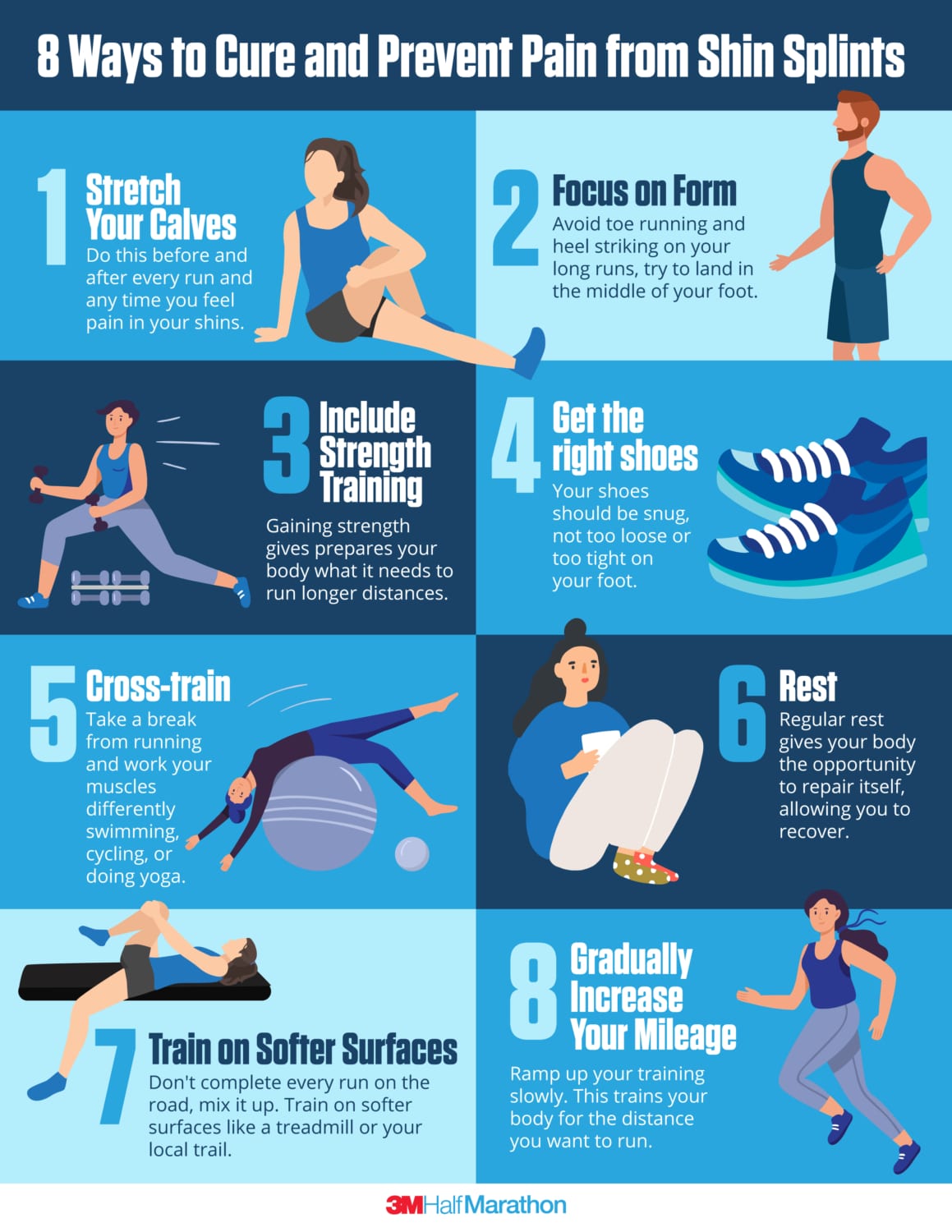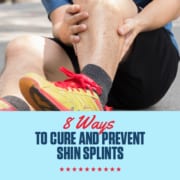8 Ways to Cure and Prevent Pain from Shin Splints
Prevent shin splints and keep your training momentum going strong
Are you a beginner runner? Then, you might’ve heard about “shin splints.” But beginner runners aren’t alone in experiencing shin splints. Veteran runners get them too. However, all runners can agree they’d rather avoid them! Shin splints describe the pain in your shin that occurs from overuse. The shinbone is the large front bone that you can find in your lower leg. Shin splints arise when bone tissues, tendons, and muscles overwork. The good news is there are ways to cure and prevent it. Prevent shin splints with our 8 tips and keep your half marathon training on track. Pro tip: click on the image, download the PDF, and post it where it’ll remind you about these tips!
1. Stretch your calves
 Do you feel mild shin pain? If you are running, stop and do a quick calf stretch. This should relieve your pain. To prevent shin splints, you should make it a practice to stretch your calves after every workout session. Regularly doing this will help prevent injury to your calves as well. Pro tip: with your right foot, place your toes on top of a curb and your heel at the bottom. Lean forward or try to grab your toes. Do this for 10 seconds, then switch to your left.
Do you feel mild shin pain? If you are running, stop and do a quick calf stretch. This should relieve your pain. To prevent shin splints, you should make it a practice to stretch your calves after every workout session. Regularly doing this will help prevent injury to your calves as well. Pro tip: with your right foot, place your toes on top of a curb and your heel at the bottom. Lean forward or try to grab your toes. Do this for 10 seconds, then switch to your left.
2. Focus on form
One method you can try to prevent shin splints is to change your foot strike. Try avoiding toe running and heel striking on your long runs. On your next run, try to land in the middle of your foot. When you land on your heel, it can stress your heels. In the same way, when you land on your toes, calf muscles are impacted. Both of these methods can contribute to shin splints and other injuries. Pro tip: learn how your stride and cadence can impact your form.
3. Include strength training
If you get shin pain during half marathon training, it could be linked to weak anterior tibialis muscles. These muscles are located on the front side of your lower leg. They make your foot flexible at your ankle. Did you increase your distance too fast? This could be a cause of your pain. You increase the likelihood of injury if your body doesn’t possess the strength needed to run long distances.
4. Get the right shoes
For some runners, shin splints can arise due to running in the wrong shoes. Make sure you choose shoes that are specific for runners and fit your running stride. Don’t run in shoes that are old or have more than 300 miles on them. You want your shoes to be snug, not too loose or too tight. Schedule an appointment with our friends at Fleet Feet Austin and get fitted for the right shoes!
5. Cross-train
Take a break from running and cross-train. These workouts will give your body a break from the strain of running and the impact on your shins. When you run, your body uses muscles in a specific, repetitive manner. Cross-training works those muscles differently and can strengthen them. Examples of workouts you can do include aqua jogging, cycling, yoga, and swimming. Learn more about cross-training and how it helps you avoid these 5 training mistakes. Pro tip: while you aren’t logging miles, you’re still working towards your ultimate goal!
6. Rest
Rest is absolutely vital. It provides your body with the opportunity to repair itself. If your training plan calls for a rest day, take it. Use your foam roller for 15-20 minutes if you get the itch to go for a run. If you’ve just started running, exercise once or twice a week. Increase the amount of exercise as you become more comfortable with the workouts or the distance you’re running. Give your body the rest it needs!
7. Train on softer surfaces
Some beginner runners get shin splints because they run on harder surfaces. Running on the roads isn’t the only way to accrue miles. Try running on softer surfaces. If you have access to a treadmill, try alternating your runs between the treadmill and the road. Are there trails near you? Get out on the trails! You’ll avoid the unforgiving concrete and all the traffic. Plus, trail running forces you to slow down, naturally causing you to change where your foot strikes. This breaks up the repetitive motions from road running. Pro tip: due to the constantly changing terrain, trail running can strengthen your lower body.
8. Gradually increase your mileage
Shin splints while training is common, especially if you have recently intensified your training routine. If you are a beginner, you should gradually increase your mileage during your training. Runners returning from injury should slowly increase their mileage. Increasing your mileage gradually is another way to strengthen your body over time and prepare it for the distance you want to run.
Nobody wants to experience shin splints, especially runners. It can derail your training and set your timeline back. The best approach is a proactive one. Properly utilize our 8 tips to prevent pain from shin splints and keep your training on track. Do you have a way to avoid shin splints? Let us know in the 3M Half Marathon Facebook Group or on Twitter.









